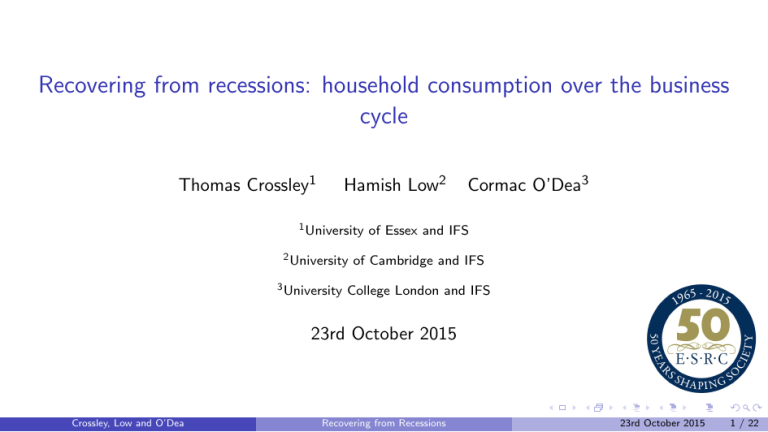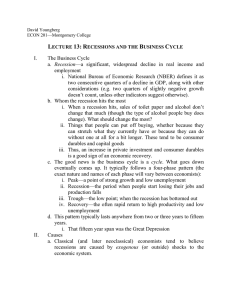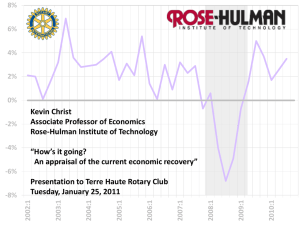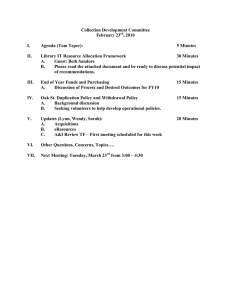Recovering from recessions: household consumption over the business cycle Thomas Crossley Hamish Low
advertisement

Recovering from recessions: household consumption over the business cycle Thomas Crossley1 Hamish Low2 1 University 2 University 3 University Cormac O’Dea3 of Essex and IFS of Cambridge and IFS College London and IFS 23rd October 2015 Crossley, Low and O’Dea Recovering from Recessions 23rd October 2015 1 / 22 Introduction Patterns and Puzzles in Household behaviour 1 Savings behaviour in recessions 2 How does behaviour differ across groups? Split by age, by housing tenure F 3 Impact of leverage Durable vs Non-durable Spending Patterns F F Different speeds of recovery Long-run changes in volatility Crossley, Low and O’Dea Recovering from Recessions 23rd October 2015 2 / 22 Savings Behaviour Income over the past three recessions Real disposable income, per capita 90 100 Index 110 120 Using GDP deflator -10 0 10 20 Quarters since recession started 2008 1980 Crossley, Low and O’Dea Recovering from Recessions 30 1990 23rd October 2015 3 / 22 Savings Behaviour Expenditure over the past three recessions Real total expenditure, per capita 90 100 Index 110 120 Using GDP deflator -10 0 10 20 Quarters since recession started 2008 1980 Crossley, Low and O’Dea Recovering from Recessions 30 1990 23rd October 2015 4 / 22 Savings Behaviour Household Saving Ratio over the past three recessions -.1 -.05 Difference .05 0 .1 Household saving ratio, difference -10 0 10 20 Quarters since recession started 2008 1980 Crossley, Low and O’Dea Recovering from Recessions 30 1990 23rd October 2015 5 / 22 Savings Behaviour: Summary Spike in savings around start of recession. Similar in UK and US Negative correlation between savings and growth in GDP Puzzling because consumption should be smoothed through shocks Crossley, Low and O’Dea Recovering from Recessions 23rd October 2015 6 / 22 Savings Behaviour: Summary Spike in savings around start of recession. Similar in UK and US Negative correlation between savings and growth in GDP Puzzling because consumption should be smoothed through shocks Crossley, Low and O’Dea Recovering from Recessions 23rd October 2015 6 / 22 Savings Behaviour: Summary Spike in savings around start of recession. Similar in UK and US Negative correlation between savings and growth in GDP Puzzling because consumption should be smoothed through shocks Explanations (Alan, Crossley and Low, 2014) 1 Shocks of recessions are permanent to the individual: ∆PDI reflects transitory income, GDP growth permanent 2 Recessions generate uncertainty in permanent income Crossley, Low and O’Dea Recovering from Recessions 23rd October 2015 6 / 22 Differences across Groups post-2008: Age Income Income, 2008 recession 95 100 Index 105 110 115 120 Per capita by age 2006q1 2009q1 2012q1 2015q1 Quarter <=35 36-65 >=65 Largest income fall for middle-aged, Old recover fastest Crossley, Low and O’Dea Recovering from Recessions 23rd October 2015 7 / 22 Differences across Groups post-2008: Age Expenditure Expenditure, 2008 recession 80 90 Index 100 110 120 Per capita by age 2006q1 2009q1 2012q1 2015q1 Quarter <=35 36-65 >=65 Middle-aged and young both cut expenditure Crossley, Low and O’Dea Recovering from Recessions 23rd October 2015 8 / 22 Differences across Groups post-2008: Age Saving Ratio Saving Ratio, 2008 recession -.05 0 Difference .05 .1 .15 By age 2006q1 2009q1 2012q1 2015q1 Quarter <=35 36-65 >=65 Saving of all age groups rises - not just about credit constraints Crossley, Low and O’Dea Recovering from Recessions 23rd October 2015 9 / 22 Differences across Groups post-2008: Age Summary Income fall particularly for middle aged; fast recovery for the old Savings increased for all groups; especially for the young Explanations 1 Suggests supply of credit is not the driver of savings spike 2 Role of uncertainty 3 Wealth effects Crossley, Low and O’Dea Recovering from Recessions 23rd October 2015 10 / 22 Differences across Groups post-2008: Housing Tenure Expenditure Expenditure, 2008 recession 85 90 Index 95 100 105 110 Per capita, by housing tenure 2006q1 2009q1 2012q1 2015q1 Quarter Renter Mortgagor Owner Out. Sharp fall in expenditure for mortgage holders Crossley, Low and O’Dea Recovering from Recessions 23rd October 2015 11 / 22 Differences across Groups post-2008: Housing Tenure Saving Ratio Saving Ratio, 2008 recession -.05 0 Difference .05 .1 .15 By housing tenure 2006q1 2009q1 2012q1 2015q1 Quarter Renter Crossley, Low and O’Dea Mortgagor Recovering from Recessions Owner Out. 23rd October 2015 12 / 22 Differences across Groups post-2008: Housing Tenure Summary / Puzzle Expenditure falls most for mortgagors Sharp spike up in savings How large is the wealth shock? Crossley, Low and O’Dea Recovering from Recessions 23rd October 2015 13 / 22 Differences across Groups post-2008: Housing Tenure Wealth Shocks What is the change in net wealth, W , following a house price fall? ωt ∆W = πt Wt (1 − Lt ) L : Leverage (debt to gross wealth) ω : Exposure (share of housing in gross wealth) π : Return on housing (percentage change in house price) Crossley, Low and O’Dea Recovering from Recessions 23rd October 2015 14 / 22 Differences across Groups post-2008: Housing Tenure Wealth Shocks What is the change in net wealth, W , following a house price fall? ωt ∆W = πt Wt (1 − Lt ) L : Leverage (debt to gross wealth) ω : Exposure (share of housing in gross wealth) π : Return on housing (percentage change in house price) Change in net wealth depends on Exposure and Leverage. Crossley, Low and O’Dea Recovering from Recessions 23rd October 2015 14 / 22 Differences across Groups post-2008: Housing Tenure Wealth Shocks What is the change in net wealth, W , following a house price fall? ωt ∆W = πt Wt (1 − Lt ) L : Leverage (debt to gross wealth) ω : Exposure (share of housing in gross wealth) π : Return on housing (percentage change in house price) Change in net wealth depends on Exposure and Leverage. Mortgagors: high exposure and high leverage Crossley, Low and O’Dea Recovering from Recessions 23rd October 2015 14 / 22 Differences across Groups post-2008: Housing Tenure Wealth Shocks What is the change in net wealth, W , following a house price fall? ωt ∆W = πt Wt (1 − Lt ) L : Leverage (debt to gross wealth) ω : Exposure (share of housing in gross wealth) π : Return on housing (percentage change in house price) Change in net wealth depends on Exposure and Leverage. Mortgagors: high exposure and high leverage Crossley, Low and O’Dea Recovering from Recessions 23rd October 2015 14 / 22 Differences across Groups post-2008: Housing Tenure Wealth Shocks What is the change in net wealth, W , following a house price fall? ∆W ωt = πt Wt (1 − Lt ) Age 25: on financial wealth, leverage 0.9, exposure 100%. ⇒ Multiplier on house price change: 10 Crossley, Low and O’Dea Recovering from Recessions 23rd October 2015 15 / 22 Differences across Groups post-2008: Housing Tenure Wealth Shocks What is the change in net wealth, W , following a house price fall? ∆W ωt = πt Wt (1 − Lt ) Age 25: on financial wealth, leverage 0.9, exposure 100%. ⇒ Multiplier on house price change: 10 Age 25: on all human and financial wealth - leverage becomes 0.1, exposure 0.11 ⇒ Multiplier on house price change: 0.13 Importance of uncertainty about permanent income Crossley, Low and O’Dea Recovering from Recessions 23rd October 2015 15 / 22 Durables vs Non-Durables Non-durables have not recovered 90 95 Index 100 105 110 115 Nondurable consumption, per capita -10 0 10 20 Quarters since recession started 2008 1980 30 1990 Updated from Crossley, Low and O’Dea (2013). Fall after 2008 is particularly in food expenditure. Crossley, Low and O’Dea Recovering from Recessions 23rd October 2015 16 / 22 Durables vs Non-Durables Durables have recovered quickly 80 100 Index 120 140 Durable spending, per capita -10 0 10 20 Quarters since recession started 2008 1980 30 1990 Updated from Crossley, Low and O’Dea (2013) Crossley, Low and O’Dea Recovering from Recessions 23rd October 2015 17 / 22 Durables vs Non-Durables How fast do durables recover compared to non-durables? Show ratio of quantity of durables to quantity of nondurables in 1980 and 2008 Crossley, Low and O’Dea Recovering from Recessions 23rd October 2015 18 / 22 Durables vs Non-Durables How fast do durables recover compared to non-durables? Show ratio of quantity of durables to quantity of nondurables in 1980 and 2008 80 90 Index 100 110 120 Ratio Durable-nondurable volume -10 0 10 20 Quarters since recession started 2008 Crossley, Low and O’Dea 30 1980 Recovering from Recessions 23rd October 2015 18 / 22 Durables vs Non-Durables Volume Ratios: 1980 and 2008 Difference is mainly in the spike end 2008/2009: VAT cut and Scrappage, Crossley, Low and Sleeman, 2015 Crossley, Low and O’Dea Recovering from Recessions 23rd October 2015 19 / 22 Durables vs Non-Durables Cross-Section Variability 2 2.5 Ratio 3 3.5 Ratio of Durable to Nondurable CV 1980 1990 2000 Year 2010 2020 Decline in cross-section variability and time-series volatility Crossley, Low and O’Dea Recovering from Recessions 23rd October 2015 20 / 22 Durables vs Non-Durables: Explanations 1 Decline in volatility of prices 2 Decline in covariance of prices with business cycle Crossley, Low and O’Dea Recovering from Recessions 23rd October 2015 21 / 22 Durables vs Non-Durables: Explanations 1 Decline in volatility of prices 2 Decline in covariance of prices with business cycle 3 Decline in durablity / increase in depreciation 4 Durables less luxurious Crossley, Low and O’Dea Recovering from Recessions 23rd October 2015 21 / 22 Conclusions Three patterns to understand: 1 Savings spikes F Savings spike up in recessions (US and UK) F Common for all age groups F Role of uncertainty Crossley, Low and O’Dea Recovering from Recessions 23rd October 2015 22 / 22 Conclusions Three patterns to understand: 1 2 Savings spikes F Savings spike up in recessions (US and UK) F Common for all age groups F Role of uncertainty Mortgage holders cut expenditure the most - leverage and exposure F Need to account for all wealth in thinking about leverage? Crossley, Low and O’Dea Recovering from Recessions 23rd October 2015 22 / 22 Conclusions Three patterns to understand: 1 2 Savings spikes F Savings spike up in recessions (US and UK) F Common for all age groups F Role of uncertainty Mortgage holders cut expenditure the most - leverage and exposure F 3 Need to account for all wealth in thinking about leverage? Durables F Ratio of durable to non-durable spending similar to other recessions F Both growing slower than previous recessions F Nature of durables has changed: spending less volatile Crossley, Low and O’Dea Recovering from Recessions 23rd October 2015 22 / 22




